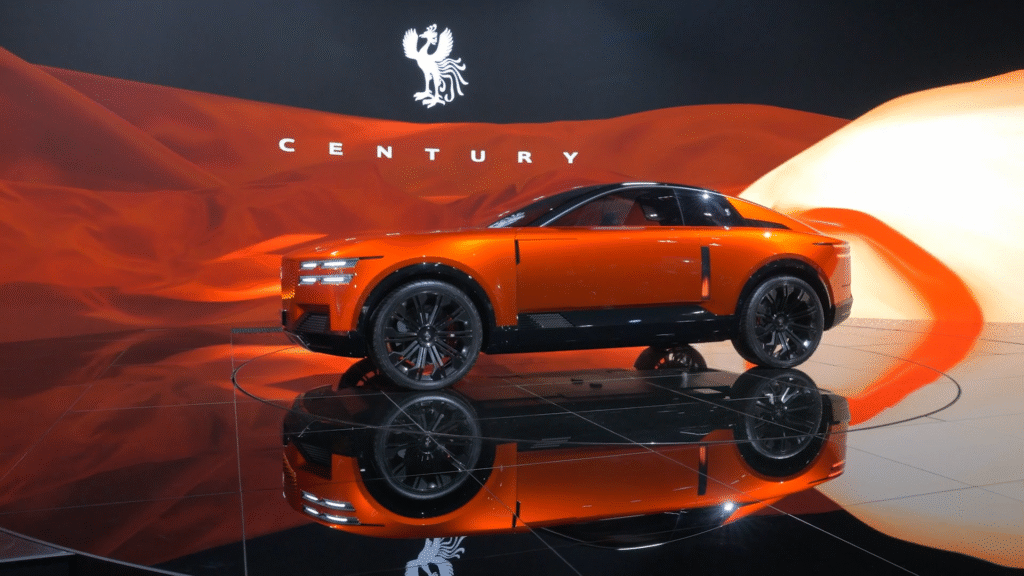Toyota’s Secret Rolls-Royce Killer? The Century Brand Aims for Global Luxury Dominance

For half a century, the Toyota Century was the quietest luxury car in the world. It carried Japanese emperors, prime ministers, and CEOs behind curtains of black lacquer paint, in total silence. It was a symbol of authority, not extravagance. You couldn’t buy one unless Toyota invited you to. It was never sold outside Japan. It was never meant to be global.
That all changed at the 2025 Japan Mobility Show, when Toyota did something completely unexpected. It didn’t unveil just a new model; it unveiled a new brand, a full-fledged luxury marque called Century, designed to stand above Lexus. The company confirmed that Century would now be a stand-alone global brand, positioned to rival Rolls-Royce and Bentley.
Akio Toyoda, the company’s charismatic chairman, described it like this: “Century is the pride of Japan, built one by one for the world.” He wasn’t exaggerating. The brand’s tagline, “One of One”, is a direct shot across the bow at Europe’s hand-built luxury elite.
The idea is simple but profound. Where Lexus represents cutting-edge hybrid technology and mass-luxury precision, Century represents Japanese craftsmanship, culture, and stillness. In an era when carmakers chase battery ranges and software updates, Toyota is betting that serenity, not speed, will define the next era of luxury mobility.
What makes Century different?
Let’s start with the way Toyota builds these cars. Each Century is assembled in the Tahara Plant by a small team of engineers known as Century Meisters. Every vehicle is hand-inspected for three and a half hours before leaving the factory. The paint alone can take weeks to complete, polished to mirror perfection. If a single swirl mark is found, the car goes back for another round of detailing.
The brand currently includes two models and a third on the way.
- Century SUV, launched in Japan in late 2023, powered by a 3.5-liter V6 plug-in hybrid system with E-Four Advanced all-wheel drive. It’s tuned not for power, but for silence. There’s an entire drive mode called Rear Comfort, designed to smooth out acceleration and braking so the rear passengers don’t spill their tea. Rear doors open 75 degrees, with power steps and C-pillar grab handles, because grace matters.
- The Century Sedan, the legendary chauffeur car still reserved for Japan’s elite, retains its stately proportions and hybrid V8 drivetrain.
- The Century Coupe Concept, revealed at the 2025 Japan Mobility Show, is a two-door fastback with sliding side doors, deep-red paint containing sixty micro-layers of pigment, and interior space equivalent to that of an SUV. It’s a design statement aimed squarely at Bentley’s Continental GT and Rolls-Royce’s Spectre.
Toyota has not yet confirmed production of the coupe, but executives hinted that its styling previewed the future of the Century line.
How does it compare to rivals?
The Century SUV competes in a league with the Rolls-Royce Cullinan and Bentley Bentayga, but philosophically, it’s a different animal. The Cullinan is a palace on wheels, the Bentayga is a performance SUV in a tuxedo. The Century is neither. It’s a mobile tea ceremony, a car that makes time slow down.
Instead of a 600-horsepower V12, you get a hybrid system designed for calm. Instead of launch control, you get laminated glass partitions, reclining airline seats with massage programs, and whisper-quiet air suspension. Each car is hand-tuned by master inspectors to ensure the hum of the tires is barely audible.
In a test drive covered by Car and Driver, engineers said the sound insulation inside the Century was “so complete, it felt like the outside world was switched off.” That’s the point.
The Century Coupe Concept, meanwhile, shows Toyota is willing to rewrite luxury design language entirely. It combines the intimacy of a grand tourer with the indulgence of a private jet. The sliding doors, unconventional for a coupe, allow dignified entry even in tight city spaces. It’s a nod to Japanese hospitality: luxury that accommodates, not intimidates.
And then there’s the branding. Rolls-Royce sells power and prestige; Bentley sells performance and flair. Century sells peace of mind. Its phoenix emblem, the mythical bird that appears when the world is at peace, encapsulates the philosophy.
Who is this for, and who should skip it?
If you think luxury means diamond-quilted seats and a thousand-watt sound system, Century isn’t for you. If you think luxury means stillness, you’ll understand it instantly.
Toyota designed Century for the “quiet billionaire.” These are the founders, philanthropists, and artists who don’t crave attention but appreciate detail. They don’t want another status symbol; they want something with meaning.
Inside, you’ll find handcrafted Nishijin-ori silk headliners, wood inlays from Kyoto workshops, and paint inspired by traditional Japanese lacquerware. Even the door hinges are over-engineered for slow, dignified motion.
As for what you won’t find: there’s no aggressive body kit, no carbon-fiber spoilers, and no screaming exhaust. The hybrid powertrain operates in near-silence for up to 40 miles of pure electric range before the gasoline engine gently joins in.
Century buyers also enjoy concierge-style ownership. In Japan, “Century Meisters” personally deliver and service each vehicle. Future global buyers, including those in China, the UAE, and possibly the U.S., will likely interact with similar concierge networks through select Lexus dealerships.
This is not a car for Instagram influencers. It’s for people who appreciate a car built with the same philosophy as a calligrapher painting a single stroke: no noise, no rush, absolute focus.
The business strategy behind the silence
Toyota’s creation of the Century brand isn’t just a vanity project. It’s a strategic move in a changing luxury landscape. Global wealth is shifting eastward, and younger affluent buyers are redefining what “luxury” means.
In an interview with Bloomberg, industry analyst Takao Shimizu explained, “The luxury car of tomorrow won’t compete on horsepower or screen size, but on narrative. People buy stories now, stories about heritage, sustainability, and identity.”
That’s precisely what Century provides. It offers a Japanese story told in a global language of design and refinement.
By separating Century from Lexus, Toyota effectively creates a two-tiered luxury structure. Lexus remains the brand of innovation, electrification, connected tech, and autonomous driving, while Century becomes the brand of tradition, craftsmanship, and slow luxury.
As Automotive News reported, this dual-brand approach mirrors what the Volkswagen Group does with Audi and Bentley, or what BMW does with Rolls-Royce. The difference is cultural: Toyota is bringing Japanese spiritual calm to an arena long dominated by Western extravagance.
What about North America?
Officially, Toyota has not confirmed U.S. sales for any Century model. But the groundwork is being laid. The Century SUV has already been engineered in left-hand drive for China, and insiders hint that certification paperwork is quietly being prepared for limited U.S. import.
If it happens, Century will not appear in Toyota showrooms. Expect a handful of Lexus flagship dealers to act as Century Studios, offering private viewing rooms and tailored experiences. These locations would function more like art galleries than car dealerships.
The likely first arrival would be the SUV. Its body style fits American tastes, and its plug-in hybrid system aligns with Toyota’s multi-pathway carbon-neutrality strategy. The sedan may follow in even smaller numbers, perhaps as a collector’s piece.
The Coupe Concept, if green-lit, could act as Century’s global halo, a showpiece to attract attention and signal capability, much like Lexus’s LFA did a decade ago.
A short history of quiet excellence
The first Toyota Century appeared in 1967, celebrating the hundredth birthday of Toyota founder Sakichi Toyoda. The name “Century” literally commemorated that milestone. It was designed to be Japan’s answer to state limousines from Cadillac and Mercedes-Benz but executed with Japanese restraint.
The second generation arrived in 1997, and it remains a legend. It was the only Toyota ever built with a V12 engine. It wasn’t about power, the car barely broke 300 horsepower, but about prestige. That V12 was designed for smoothness and silence, not speed.
In 2018, Toyota unveiled the third-generation Century, replacing the V12 with a hybrid V8. Purists gasped, but the result was better performance, lower emissions, and even more refinement.
Then in 2023 came the biggest shock: the Century SUV, Toyota’s first attempt to translate chauffeur luxury into crossover form. It was followed in 2025 by the official announcement of the Century brand itself, complete with a new logo, new business division, and a promise of “expanding beyond the automobile.”
That phrase might sound abstract, but insiders suggest it points to Century-branded lifestyle experiences: chauffeur services, travel partnerships, and even furniture and apparel lines echoing the same materials and design principles.
Why Toyota might actually pull it off
Skeptics might dismiss Century as Toyota’s vanity project, an attempt to chase Rolls-Royce in an arena it doesn’t understand. But they’d be underestimating the company’s cultural awareness and patience.
Toyota plays the long game. It spent decades perfecting Lexus before introducing the LFA supercar. It spent years refining hybrid technology before moving into hydrogen. It’s now applying that same deliberate philosophy to luxury.
And remember, Toyota isn’t starting from scratch. The Century badge already carries six decades of prestige inside Japan. The sedan’s customer list includes heads of state, royalty, and business magnates. It has the credibility; now it just needs global recognition.
Furthermore, the brand’s sustainability advantage can’t be ignored. While Bentley and Rolls-Royce scramble to electrify their lineups by the end of the decade, Toyota already has mature hybrid and fuel-cell technology. A future Century EV or hydrogen limousine is not just possible, it’s inevitable.
By combining heritage with forward-thinking engineering, Toyota might just outclass the Europeans at their own game.
The cultural ripple effect
Beyond the automotive world, the rise of Century symbolizes a larger shift in global taste. Luxury consumers are becoming more diverse, younger, and more design-literate. The old markers of wealth, ostentatious badges and chrome, are fading. Discretion is the new decadence.
In that sense, Century is perfectly timed. It embraces cultural identity, authenticity, and emotional value, the very things modern buyers crave.
If Rolls-Royce embodies British theater and Bentley embodies continental power, Century embodies Japanese serenity. It’s not a car that roars; it hums. It’s not luxury as intimidation; it’s luxury as meditation.
The bottom line
The new Century brand is more than Toyota flexing its muscles. It’s a statement about where global luxury is headed. Quiet, sustainable, handcrafted, emotionally intelligent.
When the first left-hand-drive Century SUVs eventually arrive in North America, they won’t outsell Rolls-Royce or Bentley. They don’t need to. They’ll redefine what the uppermost tier of automotive luxury looks and feels like, with less noise and more nuance.
For buyers who find Bentley a bit brash and Rolls-Royce a bit showy, the Century may be the ultimate expression of understatement. It’s a car that doesn’t just move you from place to place; it recalibrates how you move through the world.
And that might be Toyota’s most luxurious idea yet.






